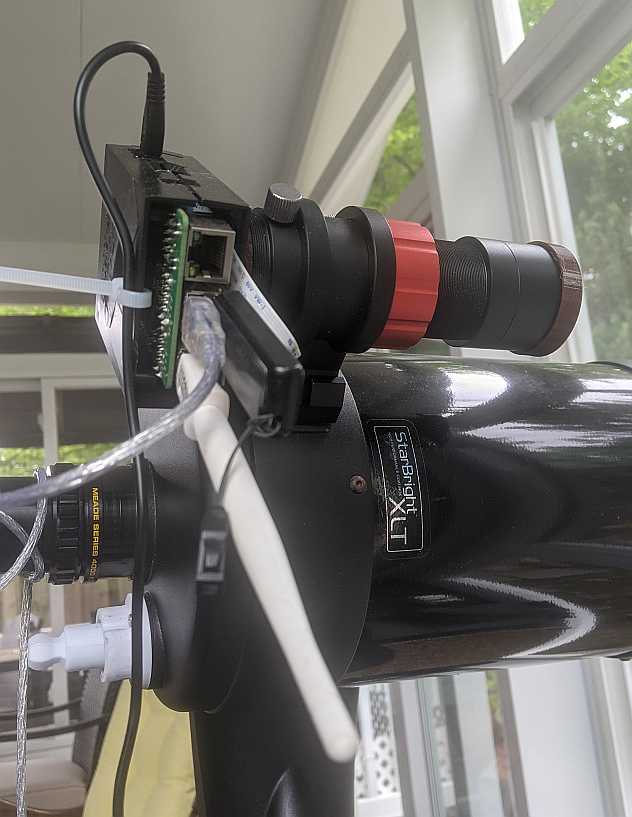
The response below assumes you are using the CelestronGPS driver for the AVX.
This driver 'protects' the hand controller mount model by not allowing setting either time or location after you have gone through a HC initial aligment. If you set the location or time after the initial align, the HC internal model will break.
-BUT- if you never use the HC for anything and only use computer commands, even if you set the location or time and then do a force sync, everything works fine from the computer.
I had a discusion on GIT about this, see
Time/Date/Location in Celestron GPS driver.
if interested.
I modify the driver for personal use by removing the 'check_aligned' check and allowing it to pass through as only the computer side is used and never the hand controller.
Now how to get 90 degrees out, does your location match in both kstars/ekos and the mounts site settings?
Even if the date and time are wrong, solving near the NCP should give you something near the NCP.
What RA/DEC does it show for the solution?
Gene
Read More...
I have been using a Celestron SE mount but always needed an automated startup without touching the hand controller.
A few years ago I did a servo based button pusher based on the Celestron GPS INDI driver, ok for a perm equ mounted SE
but needed too many components for portable.
Button pusher autostart
Looking at the Celestron Starsense I could not justify the $400+ cost of it on a $1000 scope.
So came up with a DIY alignment on the same principals.
Components (I already had all the pieces, just no software to do it all)
1) 6/8 SE mount
2) PI 3
3) PI V2 Noir camera
4) 3D printed custom case with camera holder to 1.25 drawtube.
5) 30mm F4 guide scope
As the Celestron AUX driver has matured now it was a perfect fit for the use.
The combined utilities:
Does three separate blind goto's to user defined coordinates offset from LST for RA, capture and solve at each position using astrometry,
sync the mount at each position using J2000 coordinates from astrometry precessed to JNOW.
I believe the utility is valid for any fully supported INDI scope/camera combination, albeit with a few tweaks.
The GIT repository if interested:
indi-scope-startup-sync
Now how well does it work:
I am in heavy light pollution
The PI V2 Noir cam can pick up usually a minimum of 9 to 13 stars in a 1.65 x 1.23 degree field using 10 second exposures
I use Astrometry indexes 4108/4109/4110
The BIG problem is the mount itself, it just wants to skitter around so the solve fails on star trails.
It retries 3 times before failing out.
Gene
Read More...
Hello all,
Any insight on this commit?
github.com/indilib/indi-3rdparty/commit/...12e8701817b44350bdd8
?
Read More...
Jasem,
I was looking for the thread/bug report(?) talking about the update changes you had made about "Test with removing a duplicate sync point to see if this may improve …
…platesolving"
What platesolving issue is this trying to fix?
Thanks!
Gene
Read More...
Hi Sven,
Do you happen to have a modern, large thumb drive (modern = fast usb3) ?
If yes, look into rpi-clone utility.
github.com/billw2/rpi-clone
It only clones used space, skipping temp files/directories created by the kernel/utilites and not needed across boots
If your PI4 is up to date firmware wise, rpiclone can give you a bootable thumbdrive which could be cloned back to the SD card if needed, or mounted after boot if need something off of it.
How much space is being used currently, a 'df -k' command in a shell will show percentages.
Gene
Read More...
I started from scratch examining all messages from Kstars containing:
"queuing responsible for"
This provided the messages sent by the high level client.
Found the
CONFIG_PROCESS.CONFIG_LOAD=On
and
TIME_UTC.UTC;OFFSET=
were the missing culprits's, primarily the CONFIG_LOAD
So anyone using celestron_aux outside of Kstars, need to make sure at least the load of config is executed, of course after the config has been set and saved, eg: GEO coordinates, etc.
Gene
Read More...
Sorry, make that Cartes Du Ciel/Skychart
Read More...
I am at a loss.Using Celestron AUX v1.9.9 and indiserver v1.9.9 on a PI 4 Buster against a Nexstar SE 6/8 mount.
The dilemma is under kstars I can successfully SYNC but under either Ccdciel or scripting the SYNC does not happen.
Attached are log snippets with both kstars and ccdciel from the log indiserver -vvv
In both cases it stars with 0 entries in the alignment data
At the end of both cases the alignment data shows 1 entry
Any out there using Celestron AUX under anything other than Kstars?
Note: There are extra log messages I added to the CelestronAUX::Sync(double ra, double dec) routine, snippet of this code adds also included.
Anyone?
Note 1: I see the same no capability to sync if I use indi_setprop's with values for RA and DEC in snippet below
indi_setprop "Celestron AUX.ON_COORD_SET.SYNC=On"
indi_setprop "Celestron AUX.EQUATORIAL_EOD_COORD.RA;DEC=RA;DEC"
Gene
Read More...
More project work on the dongle, adding GPS module and supported API
Parts cost:
PI PICO: < $8
RTC w/flash chip: $5, DS3231 with temp compensated xtal
GPS module: $9 (GY-NEO6MV2)
8X dupont wires + case + usb cable
Code supports mix and match:
PICO + RTC
PICO + GPS
PICO + RTC + GPS
Note: Without RTC + scratchpad, GPS data always streams
API:
:c Set the RTC time in unixtime Zulu
:c1676732144
Code to read from system and write to RTC
cmd = "date +%s"
print("System current unix time")
cmd1 = "\"{}\"".format(os.system(cmd))
unixtime = "{}".format(os.popen(cmd).read())
settime = unicode(":c"+unixtime[:-1])
self.ser_io.write(settime)
:C Read the RTC, response format in Zulu time
2023/02/18 14:48:34
Suitable for use in unix date set
self.ser_io.write(unicode(":C"))
self_id = self.ser_io.readline()
print("RTC current time")
print(self_id)
cmd = "date"
print("Current system time")
os.system(cmd)
cmd = "date -s \"{}Z\"".format(self_id)
print("Setting time")
os.system(cmd)
![]() Status of GPS lock
Status of GPS lock
Response
1 = locked
0 = not locked
:G Stream GPS data, state remembered across restarts if scratchpad available
Direct input to GPSD
:g Stop stream of GPS data, state remembered across restarts if scratchpad available
![]() Read the GPS date and time, response format
Read the GPS date and time, response format
2023/02/18 14:52:41
Suitable for use in unix date set, see :C command above
:L Read the GPS Longitude, response format
-77:01:02
Where negative = West
:l Read the GPS Latitude, response format
+38:01:02
Where negative = South
:Q Read GPS Lat and Long, response format
+38.123456,-77.123456
:d Read GPS time, response format
15:07:15
:T Read temperature of DS3231, response format
18.00
=========================
Scratchpad flash supported if contained on RTC module
:WXXXX,YYY Write scratchpad flash
Where XXXX = address to write to, YYY = data to write
XXXX and YYY in decimal
Max value of XXXX based on which flash on the RTC module
All digits in XXXX and YYY required
:RXXXX Read scratchpad flash
Where XXXX = address to read
XXXX in decimal
Max value of XXXX based on which flash on the RTC module
All digits in XXXX required
NOTE: address 4095 is used to store state of :Q/:q GPS streaming enable
Read More...
Hi Andrew,
For sure soldering in or making dupont splitters would work but a real tight fit in the display case but needed a project and wanted portability across multiple platforms.
That coupled with the price of PI's currently said don't open case, don't solder, don't break or mod what works.
Gene
Read More...
For my travel scope I use a PI 4 in a case with a 7inch DSI display.
Given there is no room in the case for standard methods of plugging module itself into the SDA/SCL lines and given the display uses the lines already another solution was needed for as low a cost as possible.
Seems PI PICO's have become available again for non-scalper prices and DS3231 modules with battery are readily available so a bit of code on the PICO and a few wires to the DS3231 module coupled with some python scripts on the PI to allow plugging the gadget (PICO+DS3231) into PI's USB and both setting the time into the gadget and setting system time from the gadget.
The solution is pretty much universal and can be used on basically any linux or windows or mac machine where there is admin access to modify the system time.
If any interest, I can provide more info, code, wiring, etc.
Gene
Read More...
Massimo,
I am a little surprised this info on no astrometry logging has gone unnoticed for a month since first posting.
Gene
Read More...
Hi Bernd,
I make the assumption this is a build from Master? Maybe too close living on the edge as in Skysafari client, Toup items not up to date with 2.0.0 ?
Gene
Read More...
Basic Information
-
Gender
Male -
Birthdate
12. 04. 1966 -
About me
Long time scope user
Contact Information
-
City / Town
Philly -
Country
United States




